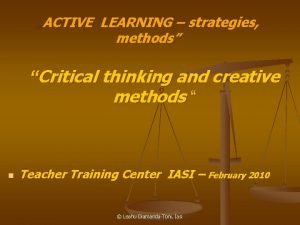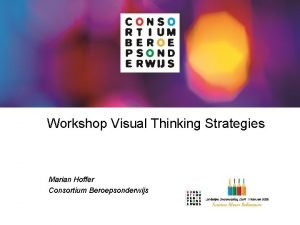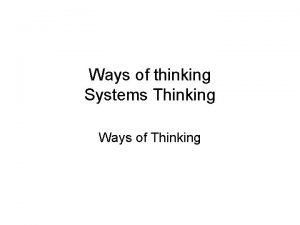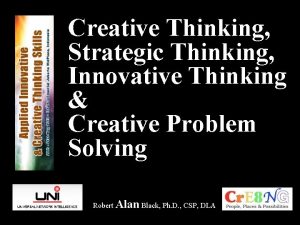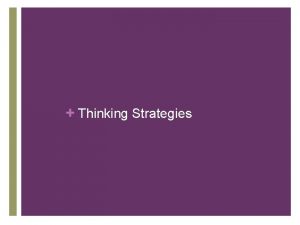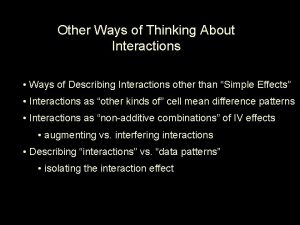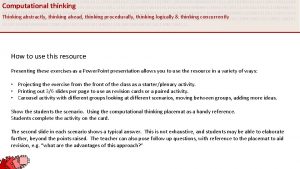Thinking Strategies for Innovative Leaders Ways to avoid






























- Slides: 30

Thinking Strategies for Innovative Leaders Ways to avoid ‘winging it’. by Bill Lowe Photo by Fabrice Villard on Unsplash

Thank you for downloading this resource. We hope that the content will start you thinking about how to structure your decision making and idea generation in a way that helps to ensure sustainability. We have sourced and developed a range of activities and tools from the vast leadership community, especially those with an innovative edge. The latest professional academic thinking along with practical workplace application is at the centre of our approach. The notes are from a workshop presentation at the Thinking Schools International annual conference in June 2017. It is not intended to be read as a book. We are continually developing new ideas and resources to make leadership more innovative and effective.

Introduction As school leaders we often have to make decisions quickly. We regularly have to come up with new initiatives and strategies in order to apply other people’s strategies at short notice. We often have to make decisions about long-term policy whilst under pressure. This scenario leads us to apply our naturally programmed modes of thinking. Whilst there is nothing wrong with this, it is allowing us to make decisions that are not always thought through well enough. Sometimes ‘off the cuff’. It is known that time constraints have a negative impact on creativity and innovation. Thinking Strategies for Innovative Leaders is the starting point for us to be proactive in our thought strategy selection. It is about moving away from the default position to one of genuine creativity. You will be able to identify things that are not new to you, but probably haven’t given yourself time to consider and implement.

The first thing to consider is where our leadership thinking sits with regards to how we encourage others to think in their roles. Respond to the next slide.

Do you encourage… • Your students to think about their thinking? • Your colleagues to think about their thinking? • Your leadership team members to think about their thought processes? Photo by Climate KIC on Unsplash

You probably answered ‘Yes, of course’ to all those questions. But what about your leadership work?

Be honest Do you allow yourself the time to think about your leadership thinking?

What does ‘leadership thinking’ look like? Come up with examples of Times when: • You have to think quickly • You have plenty of time • You wish you could go back and try again • Things have gone well

How often do you considered this part of your work? Never sometimes Always

Context is very important. Your working conditions have huge impact. You will agree with the quote on the next slide. Take note of its implications.

"Continual reform and change have become accepted elements of the daily work of education”. Phil Wood, University of Leicester Because of these pressures, our thinking tends to be…

REACTIVE autopilot SELECTIVE blind commitment

Look at the brief definitions of these types of thinking on the next two slides. Can you think of examples in your own daily/ weekly/ monthly performance?

Reactive Thinking: Reacting to existing influences and ideas. Doing something in a particular way because it’s always worked reasonably well in the past. Photo by Clark Young on Unsplash

Selective Thinking: Validating previous strategies and then implementing them. Choosing a particular path because we can’t think of any alternatives… because we haven’t looked for anything different. Photo by Niklas Hamann on Unsplash

There is nothing wrong with reactive and selective thinking. They are natural ways of thinking that allow us to make decisions quickly. This is especially so when time is tight and we are up against deadlines. However, they are inefficient if they are the only strategies we use.

“The human understanding, when it once has adopted an opinion, draws all things else to support and agree with it. ” Sir Francis Bacon

But does doing what we’ve always done leave us open to these colleagues… who are ‘never wrong’?

An effective way of avoiding the thinking trap is to become a PROACTIVE THINKER “Most of us go through our lives without being aware of the thinking processes behind the decisions we make. We operate on autopilot (i. e. reactive thinking). ” Chris Griffiths – author of GRASP

Proactive thinking helps us to • identify appropriate thinking methodologies • provide a conscious and focused approach that is > objective > creative > effective and innovative

A good starting point is to identify two powerful thinking strategies: • Generative thinking • Analytical thinking Deciding when to apply these strategies shows you are being a Proactive thinker. Important message This is the key to being an innovative leader.

The next two slides give you an outline of what these strategies bring to idea generation and application as well as problem solving. These are ways to apply innovative leadership.

Generative Thinking Generating thoughts and ideas 1) Strive for quantity 2) Encourage unusual and challenging ideas 3) Postpone judgement 4) Build and combine ideas

Analytical Thinking Analysing ideas to reach a conclusion 1) Evaluate using appropriate criteria 2) Use a rating system (1 -10)or SWOT analysis (or similar) 3) Ask the ‘right questions’ * 4) Select the best options 5) Decide when to put into action

Fitting the parts together Define the problem/ ask the question Generate ideas Analyse and select Put into action

Sift through the ideas from the generative phase without rejecting those which might work with some adjustment or clarification. The ANALYTICAL THINKING * But what are the ‘right questions’?

Analytical questions to ask • • What are we trying to achieve? Is there anything different about this strategy? Have we got the right people in the team? Are we all heading in the same direction? What do we hope to gain? Can we resource it? Can we clearly state our success criteria? Is it easy to say when and how are we going to monitor developments?

If the response to any of these questions is: “We don’t know” go back a step and find the answer.

We hope that this brief introduction will be useful. Innovative leadership is being seen as a prime factor in moving workplaces forward, to such an extent that the most creative organisations even have budgets set aside specifically for innovation. The way leaders approach their thinking cannot be overlooked in a progressive environment. Going back to the tried and trusted is understandably needed, but too often becomes the default position. School leadership is at a point where innovators are being recognised. We can help you build your innovative skills and drive your school to the next level.

Good luck Photo by Juan Jose on Unsplash
 Gods ways are not our ways
Gods ways are not our ways Chapter 7 section 4 new ways of thinking
Chapter 7 section 4 new ways of thinking Ten ways to untwist your thinking
Ten ways to untwist your thinking Promoting alternative thinking strategies
Promoting alternative thinking strategies Active learning strategies to promote critical thinking
Active learning strategies to promote critical thinking Visual thinking strategies nederland
Visual thinking strategies nederland Active learning strategies to promote critical thinking
Active learning strategies to promote critical thinking Thinking about you thinking about me
Thinking about you thinking about me Thinking about your own thinking
Thinking about your own thinking Holistic thinking example
Holistic thinking example Perbedaan critical thinking dan creative thinking
Perbedaan critical thinking dan creative thinking Positive thinking vs negative thinking examples
Positive thinking vs negative thinking examples Verktyg för automatisering av utbetalningar
Verktyg för automatisering av utbetalningar Big brother rösta
Big brother rösta Bat mitza
Bat mitza Aktiv expektans
Aktiv expektans Sju för caesar
Sju för caesar Stig kerman
Stig kerman Verksamhetsanalys exempel
Verksamhetsanalys exempel Varför kallas perioden 1918-1939 för mellankrigstiden
Varför kallas perioden 1918-1939 för mellankrigstiden Matematisk modellering eksempel
Matematisk modellering eksempel Tack för att ni har lyssnat
Tack för att ni har lyssnat Shaktismen
Shaktismen Centrum för kunskap och säkerhet
Centrum för kunskap och säkerhet Inköpsprocessen steg för steg
Inköpsprocessen steg för steg Påbyggnader för flakfordon
Påbyggnader för flakfordon Jag har nigit för nymånens skära text
Jag har nigit för nymånens skära text Strategi för svensk viltförvaltning
Strategi för svensk viltförvaltning A gastrica
A gastrica Egg för emanuel
Egg för emanuel Relativ standardavvikelse formel
Relativ standardavvikelse formel




